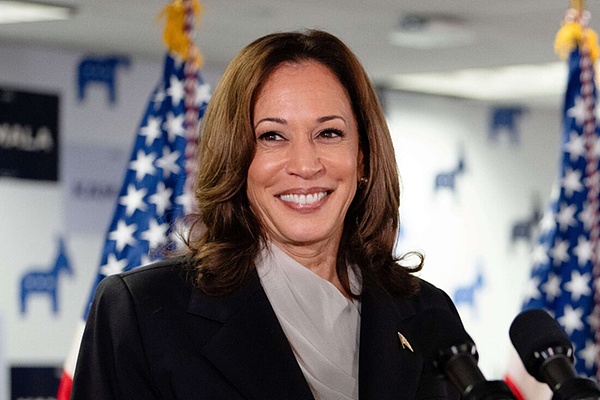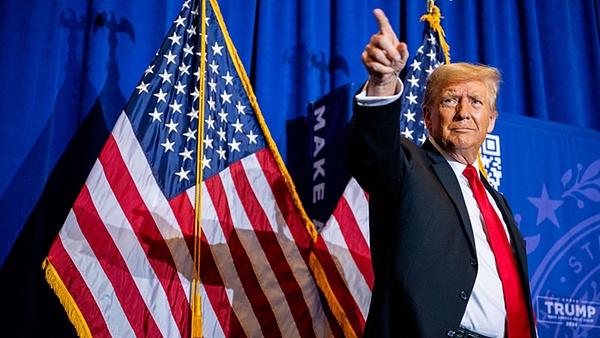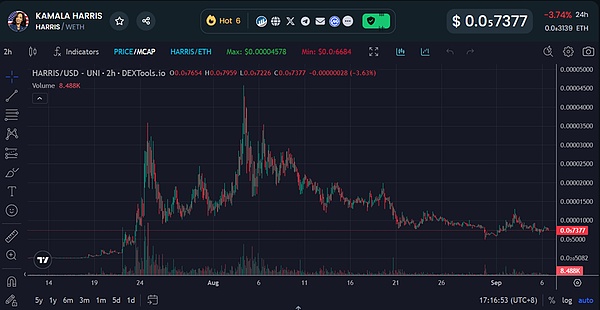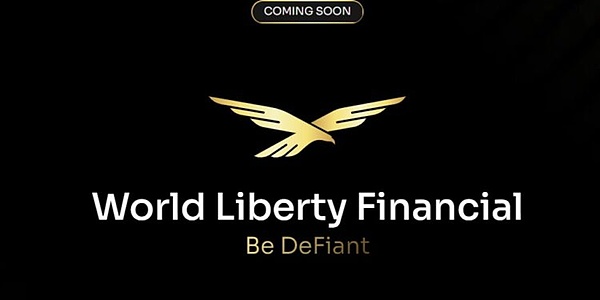Author: Shi Lian
1. Background
Attention to Bitcoin is increasing due to macro developments and the maturation of Bitcoin as an asset. In the past six months, geopolitical tensions, inflationary pressures, dollar risks and other factors have driven voters' attention to Bitcoin to continue to rise. In addition, inflation has become a top issue in this election, and the potential value that an asset like Bitcoin with a transparent supply mechanism and hard cap could have. In the context of increasing economic uncertainty, these characteristics of Bitcoin appear to provide investors with an option to hedge risks.
The Harris Poll results released by the Grayscale team further confirm this trend. The survey shows that major events such as the approval of the US spot Bitcoin ETF in January 2024 and the Bitcoin halving in April 2024 have significantly increased voters’ interest in investing in Bitcoin and other crypto assets (18% and 20% respectively ). It is particularly worth mentioning that the approval of Bitcoin ETF has made 9% of retired voters more interested in investing in Bitcoin or crypto assets. This data is particularly eye-catching among the retirement group.
Therefore, compared with previous elections, the connection between this US election and cryptocurrency is closer. We can foresee that cryptocurrency policy is likely to become an important part of candidates' election platforms and affect voters' voting preferences. At the same time, this also means that the encryption industry may usher in more regulatory attention and policy debates. Against this background, paying close attention to the candidates' attitudes and policy proposals towards cryptocurrency is not only of great significance to investors. This election may become a key turning point for cryptocurrency from the edge to the center stage.
2. Overview of U.S. election candidates
A. Harris camp
On July 21, Biden withdrew from the race and supported Vice President Kamala Harris, Harris announced her candidacy for the Democratic presidential nomination. Kamala Harris, as the current Vice President of the United States, has officially announced her candidacy for the 2024 Democratic presidential nomination. The descendant of Indian and Jamaican immigrants, Harris will become the first black woman and Asian American to lead a major party campaign if she is successfully nominated. Harris' political career was mainly developed in the Bay Area of California, where she served as a U.S. Senator, California Attorney General and San Francisco District Attorney. She has gained a reputation for her sharp prosecutorial questioning style in congressional hearings, especially in confrontations with Trump administration officials.

Photo source: Getty Images
Harry The daughter of Indian and Jamaican immigrants, Si grew up in Oakland and spent most of her political career in California's Bay Area.
Harris' first campaign speech provided some insight into her priorities, and like Biden, she intends to align her vision for America with Trump's Contrast that with Pu’s vision. The path forward, she said, will focus on lifting up working- and middle-class Americans so they can join unions, retire with dignity, no longer fear gun violence and have access to affordable health care.
1) Current cryptocurrency policy stance
While Harris' Biden administration has been criticized by the industry for its stance seen as anti-cryptocurrency, recent developments indicate that the Democratic camp may be adjusting its attitude towards cryptocurrencies:
l Future Forward USA PAC, a major source of support for Harris, has partnered with Coinbase Commerce to accept cryptocurrency donations.
l Although Harris’ campaign does not currently accept direct cryptocurrency donations, the move may signal that the Democratic Party is re-evaluating its cryptocurrency strategy.
This development may be in response to Republican opponent Donald Trump's dominance among cryptocurrency supporters.
2) Potential policy changes
Based on the current situation, we can speculate that the Harris camp may have the following changes in cryptocurrency policy:
l Gradually open attitude: Considering With the Future Forward USA PAC move, Harris may take a more open cryptocurrency policy stance to appeal to younger voters and tech industry supporters.
l Balanced regulation: A balanced regulatory framework may be proposed that protects the interests of investors without stifling innovation. This could include clear cryptocurrency classification and tax guidance.
l International competitiveness: Considering the development trend of global cryptocurrency, Harris may propose policies to ensure that the United States maintains a leading position in this field.
l Environmental concerns: Given the Democratic Party's environmental stance, Harris may propose policies that encourage the use of more environmentally friendly cryptocurrency mining and trading technologies.
B. Trump camp
Donald Trump’s camp is once again in the spotlight in the 2024 US presidential election. As the former president of the United States, Trump announced his participation in the 2024 presidential election in November 2022, trying to become the second president in U.S. history to win two non-consecutive terms.
Trump's political career is full of controversy and drama. He continued to deny the results of the 2020 election and insisted that there was fraud in the election, although these claims lacked substantial evidence and also led to the incident at the Capitol on January 6, 2021. As the only president in U.S. history to be impeached twice by the House of Representatives, Trump faces multiple legal challenges. In May 2024, he was found guilty of all charges in a hush money criminal trial in New York. He also faced charges in three other major cases involving the 2020 election and the handling of confidential documents.

Image source: CNN
Enter Before politics, Trump was a successful businessman and media personality. He graduated from the University of Pennsylvania with a bachelor's degree in economics and went on to a distinguished career in the real estate industry. As the host of the reality TV show The Apprentice, he was already a household name before entering politics. This unique background added a distinctly personal touch to his political career.
Trump's policy propositions and campaign strategies continue to emphasize the concept of "making America great again." He has promised to overhaul the federal government if re-elected, especially targeting what he calls the "deep state." In terms of economic policy, Trump emphasized the achievements of his first term and promised to restore employment and promote economic growth. He also plans to cut social safety net programs, which could have a significant impact on the existing welfare system. In terms of foreign policy, Trump advocates "America First" and may continue to adopt unilateralism and trade protectionist policies. The support base of the Trump camp mainly includes traditional conservatives, working-class voters and voters who are dissatisfied with the establishment. That controversial nature has also cemented the loyalty of his core supporters, allowing him to remain a powerful influence within the Republican Party.
Cryptocurrency attitudes during past terms
Donald Trump undergoes notable shift in cryptocurrency policy:
l Early days of White House tenure: Trump was skeptical of cryptocurrencies, in 2019 Publicly expresses "dislike" for cryptocurrencies, believing they may facilitate illegal activities.
l Attitude change: Over time, Trump gradually changed his stance and began to actively embrace cryptocurrency.
l Campaign strategy: Trump has incorporated cryptocurrency into his 2024 campaign strategy, announced that he will accept cryptocurrency donations, and promised to make the United States a "global cryptocurrency" capital".
l Business interests: The Trump family launched the World Liberty Financial project, a cryptocurrency trading platform, showing their business interest in this area .
l Policy proposition: Trump has proposed a series of policy ideas to support cryptocurrency, including: creating a Bitcoin "strategic reserve" and promoting decentralized finance. (DeFi), subsidize Bitcoin mining to increase energy production, oppose the creation of central bank digital currencies (CBDC)

3. Candidate-related token analysis
1) Harris Token
Vice President Kamala Harris’s meme token Kamala Harris Token (KAMA) also performed well. Launched in August 2023, KAMA takes its name from Vice President Harris but is not actually directly related to her.
KAMA token has experienced significant price fluctuations in the short term. According to CoinGecko data, KAMA rose by more than 100% in 24 hours, reaching a historical high of $0.03. According to historical records, KAMA’s market value has exceeded US$30 million, and its 24-hour trading volume has exceeded US$1 million.

However, as a Meme token, KAMA’s value mainly stems from social media hype and speculation rather than actual application value. Compared to other candidate tokens, KAMA appears to rely more on short-term market sentiment and speculation than on long-term value proposition. KAMA’s official website declares that its goal is to “allow everyone to participate in the future of cryptocurrency,” but does not provide specific usage scenarios or technological innovations.
2) WLF (World Liberty Financial)
The WLF project is a project founded by Trump's son. Trump himself was named the project's "chief encryption advocate," while his sons Eric and Donald Jr. served as "Web3 Ambassadors." The project's technical architecture includes a "credit account system" built on the Aave and Ethereum blockchains, designed to facilitate decentralized lending. However, it is worth noting that WLF has personnel connections with the DeFi project Dough Finance, which was previously attacked by a $2 million hacker, which may raise concerns about the security of the project.
WLF's "governance" crypto token WIF plans to allocate 70% to "founders, teams and service providers," according to a draft of the project's white paper obtained by CoinDesk. , much higher than the internal allocation ratio of other well-known crypto projects. The remaining 30% will be distributed through public sales, and part of the funds will be used to support project operations. This unusually high internal allocation ratio has aroused doubts among industry insiders, who believe that it may be contrary to the concept of "returning financial power to the people" claimed by the project.
WIF tokens are designed to be non-transferable, possibly to avoid violating securities laws. However, this feature also limits the market liquidity of the token, which may affect its future value and utility. The WLF team stated that the token economics plan has not yet been finalized, leaving the possibility of further adjustments.

4. Evaluation of investment potential of candidate tokens
1) < /strong>Speculation Opportunities
The election will definitely have a relatively large impact on the price of tokens. When the two forces are competing , the tokens represented by each are definitely difficult to distinguish. As for the role of social media and news events, they are also effective, but the role will not be too great. They can only affect short-term price fluctuations, and no matter what the political opinions of either camp are, it will be good. , policies on blockchain will not be implemented so quickly. It is mainly related to interested parties. There are many camps behind each party, and the implementation of a policy needs to go a long way and cannot be achieved casually. Moreover, most of the tokens involved in politics are Memecoin, and the sustainability of Memecoin is not long-term.
The investment potential of candidate-related tokens is closely related to the outcome of the US election. As the election process progresses, changes in the support rates of each candidate are likely to directly affect the price fluctuations of related tokens. When the two camps are evenly matched, the tokens represented by each may become indistinguishable.
Social media and news events also have a certain impact on the prices of these tokens, but they are mainly focused on short-term fluctuations. As for the impact of the final elected party’s policy implementation on the future of tokens, no matter which party’s political views, the actual implementation of blockchain-related policies often takes a long time. The formulation and implementation of policies involve multiple interests and require complex legislation and approval processes, so it is unlikely to have an immediate and sustained impact on token prices.
In addition, political-related tokens are mostly Meme coins, and the sustainability of such tokens is usually not long-term. Their value relies more on short-term hype and social media attention than on actual use cases or technological innovation.
2)Risk Analysis
Market manipulation risk
Candidate-related tokens are extremely vulnerable to market manipulation. First, since the liquidity of these tokens is typically low, large transactions can cause wild price swings. Some investors may take advantage of this to conduct "pull-in" and "smash-up" operations to obtain improper benefits. Second, the spread of false information can have a significant impact on token prices. In the age of social media, rumors or fake news about candidates can spread quickly, causing irrational fluctuations in the price of related tokens. For example, a piece of false news about a change in a candidate's policy stance could trigger a sharp rise or fall in the underlying token.
5. Conclusion
Candidate-related tokens are In the context of the 2024 U.S. election, the dual attributes of political participation tools and investment products are presented. These tokens provide supporters with a new way of political expression, while also bringing high-risk and high-reward speculative opportunities to investors.
At the same time, this phenomenon also highlights the importance of the cryptocurrency market’s urgent need to establish a more complete regulatory framework and investor protection mechanism. In the future, how to strike a balance between encouraging innovation and preventing risks will be an important issue facing policymakers.
 Brian
Brian
 Brian
Brian Brian
Brian Cointelegraph
Cointelegraph Nulltx
Nulltx Bitcoinist
Bitcoinist Cointelegraph
Cointelegraph Bitcoinist
Bitcoinist Bitcoinist
Bitcoinist Bitcoinist
Bitcoinist Cointelegraph
Cointelegraph